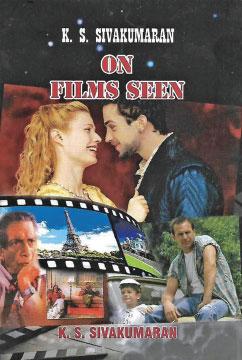
‘On Films Seen’
Author: K.S. Sivakumaran
Publisher: S. Godage & Brothers
Price: Rs. 650
Although there are many books on films in Sinhala, only a few local authors have attempted to write a comprehensive work on film-making in English. K.S. Sivakumaran is singularly qualified to comment on films as he has viewed many Sinhala, Tamil, English and Hindi films here and abroad. He has attended many film festivals and written numerous reviews for newspapers. His background as a senior journalist and a lecturer in English has helped him to put across his views clearly and without bias.
In a short preface the author says the purpose of writing the book is to enable film buffs who may not have seen some of the good films. What is not mentioned here is that there is no school in Sri Lanka for training potential film-makers. Therefore, Sivakumaran has filled a void by writing an authoritative book on films.
The opening chapter on ‘Understanding the film’ is thought provoking. It discusses the language and structure in film-making. Ordinary people see films purely for entertainment. But for a reviewer viewing a film has many purposes. This is because there are three types of films viz., commercial films, art films, and the middle cinema. The author explains in detail the properties of the language of films that consist of picture, sound, editing, lighting, and acting. In other words, the elements that form the language of film are visual shots, sound shots, and editing.
Distinction
The author draws a distinction between films and other languages. English, Sinhala, Tamil and Hindi are verbal languages. The basic symbol of all such languages is the word. Then we have drawings and photographs which are less abstract, less general and specific. However, film is the least abstract, least general and most concrete and most specific of all the languages.
Even for a casual viewer the film is a vivid experience. He gets involved in the film emotionally. Sometimes, he claps for joy and cries after seeing a tragic scene. However, filmgoers belong to a wide spectrum of categories. To cater to them there is a wide variety of films. The author gives 14 purposes of making films. Anybody interested in films would benefit from his discussion.
The author has gathered facts and figures for his columns from newspapers from eminent film-makers such as Dr. Lester James Peries and Balu Mahendran. He has also drawn inspiration from Mani Rathinam and Satyajit Ray.
Sivakumaran has devoted a whole chapter to comment on Sinhala films. He has commented on ‘Madhu Samaya, Kelimandala, Umayangana, Mandakini’ and ‘Sankranthi’. He is impressed by ‘Madhu Samaya’ which is a psychological drama of conjugal relationship. He says the film is slightly better than crude copycat productions. He is of the view that ‘Kelimandala’ has successfully engrossed the viewer with short sequences, tight editing and natural juxtapositions of flashbacks. He refers to ‘Umayangana’ as a film that pleases lovers of the macabre and horror genres. The author praises ‘Mandakini’ as a well-crafted entertainer of the highest order. For him ‘Sankranthi’ is an off-beat psychological film.
In a separate chapter on ‘Indian films among world cinema’ the author discusses the relative merits of Archana, dubbed Tamil cinema’s ‘Thinking girl’.
She starred in South Indian and Hindi films and bagged the Best Actress Award. According to Balu Mahendran, Archana “looks like the average girl next door.”
Having attended a number of international film festivals, Sivakumaran has enriched his knowledge in film-making. The reader would gather many important facts by reading his comments on some internationally reputed films.
Tamil films
In ‘A note on Lankan Tamil films’ Sivakumaran says there is scope for regional Tamil films. However, technically, commercially and content-wise the range of experience in Indian films is much wider than those of Sri Lankan Tamil language films. In his view they cannot compete with some of the average Tamil films made in Tamil Nadu.
The author who has reviewed a range of international films says, “What we see in our theatres today are films depicting gruesome violence that are chilling, blood-curdling and a primitive kind of slaughtering as well as sophisticated murder. Such violent scenes in films help only to beget violence in society at large.”
Sivakumaran has reviewed a number of German, American, South African, British, Indian, Australian, French, Latin American, Chinese, Greek, Indonesian and Finnish films. The reviews adorn the final part of the book which is a ‘must read’ for everybody connected with film production and film buffs as well.
